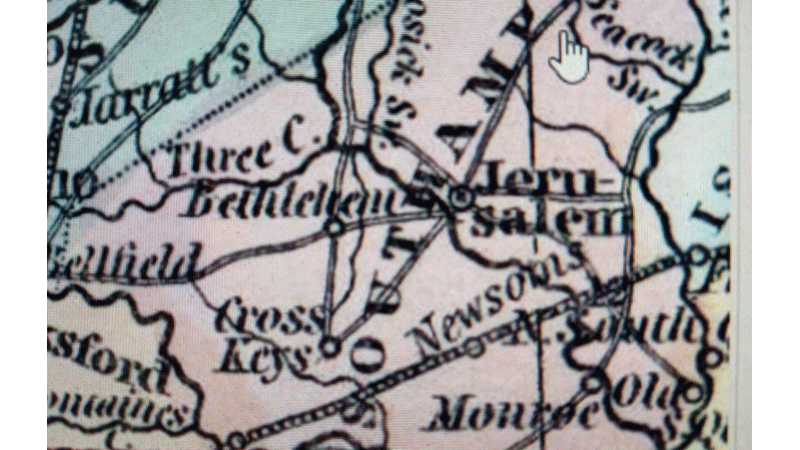The town of Monroe
Published 6:51 pm Tuesday, February 15, 2022

- The Crumpler family owned and occupied a good part of the land that became known as Monroe, going back through many generations to the mid-1800s. (Photo submitted by Clyde Parker)
|
Getting your Trinity Audio player ready...
|
In December of 1817, Clements Rochelle, owner of Brown’s Ferry, a Nottoway River crossing eight miles below Jerusalem (now, Courtland), petitioned the General Assembly of Virginia for a town at the ferry site. He pointed out that it was the highest point of navigation on the river for ocean-going vessels and that the adjacent countryside abounded in lumber, naval stores, and articles of heavy transportation. There were fisheries in the vicinity that would add much to the commerce of the Nottoway, and the river could be cleared for as much as seventy miles farther up to accommodate smaller craft. Those and other prospects seemed promising for the rise of a prosperous and flourishing town. At that time, from that area, produce and lumber were being shipped to Norfolk – by way of the Nottoway and the Chowan rivers and the Albemarle Sound.
A new town, named for incumbent President James Monroe, was incorporated in 1818: On January 1, 1818, the General Assembly of Virginia passed the following act: “The Town of Monroe is established. Ten acres of land, at Brown’s Ferry on the Nottoway River, the property of Clements Rochelle in the County of Southampton, as soon as the same shall be laid off in lots with convenient streets, be established as a town by the name of MONROE; and that John Thomas, James Rochelle, John Rochelle, Benjamin Blunt Jr., Jacob Darden and William C. Everit, gentlemen, be and they are appointed trustees thereof.”
And, a new petition before the year’s end requested permission to add 50 more acres in view of the rapidly increasing demand for property in the said town, in consequence of the commercial advantages which it presents.
About the same time, the ferry name was changed from “Brown’s Ferry” to “Monroe Ferry”.
Monroe had a post office by 1819, but the town’s development was slower than expected. By a deed in 1824, most of the land comprising the place was conveyed by Tyler Edwards to John Marchant of Worcester, Massachusetts, reserving lots owned by Hardy Cross, Zebediah Washington, John Thomas, and others along Jack’s Street, Catherine Street, Washington Street and Rochelle Alley. Such a transaction suggests that Monroe may have begun to decline, and the idea of a town appears, indeed, to have been all but abandoned even before the coming, in 1835, of the Portsmouth and Roanoke Railroad which caused a rerouting of river traffic through other channels – primarily the Blackwater River.
It is evident that the establishment of the Portsmouth and Roanoke Railroad and its crossing the Blackwater River at a point that was to become the onset of the development of Franklin Depot and its riverport, later, was a further deterrent to the development of Monroe as a more significant riverport and community; South Quay was another factor.
Another problem for Monroe may have been the costs involved in attempting to maintain the Nottoway’s shallow and twisting channel intact; periodically, freshets threw up fresh sandbars or laid down intricate new patterns of logs and debris – discouragements to ship captains.
Incidentally, another venture by Clements Rochelle, along with Jeremiah Cobb, was, in 1834, the construction of a new courthouse at Jerusalem to replace an earlier courthouse, built in 1798, that was used for the trials involving the Nat Turner uprising. At that time, Rochelle was sheriff of Southampton County and Cobb was a judge for some of the trials.
A single circumstance, however, gave Monroe a footnote in history: the birth, there, on Dec. 1, 1826, of William Mahone, who was destined for a remarkable career as a Confederate general, Virginia State Senator, and U.S. Senator. His father, Fielding Jordan Mahone, was locally celebrated as a mathematician and English scholar, but William may have owed his warlike propensities to a kinsman whose Irish heritage manifested itself in occasional donnybrooks.
The Crumpler family owned and occupied a good part of the land that became known as Monroe, going back through many generations to the mid-1800s. An 1863 map shows significant land ownership by members of the Crumpler family, namely Joshua Crumpler and Edward Crumpler. Descendants of those Crumplers are still there, including P. D. (Dan) Crumpler III who is a great-great grandson of Joshua Crumpler and a great-great-great grandson of Edward Crumpler.
In 1906, a steel bridge with wood planking was built to replace the Monroe ferry crossing. The current Monroe Bridge was constructed in 1999.
In the present day, Monroe is a pleasant rural community – bisected by the beautiful and winding Nottoway River and the bridge that spans it.
CLYDE PARKER is a retired human resources manager for the former Franklin Equipment Co. and a member of the Southampton County Historical Society. His email address is magnolia101@charter.net.





